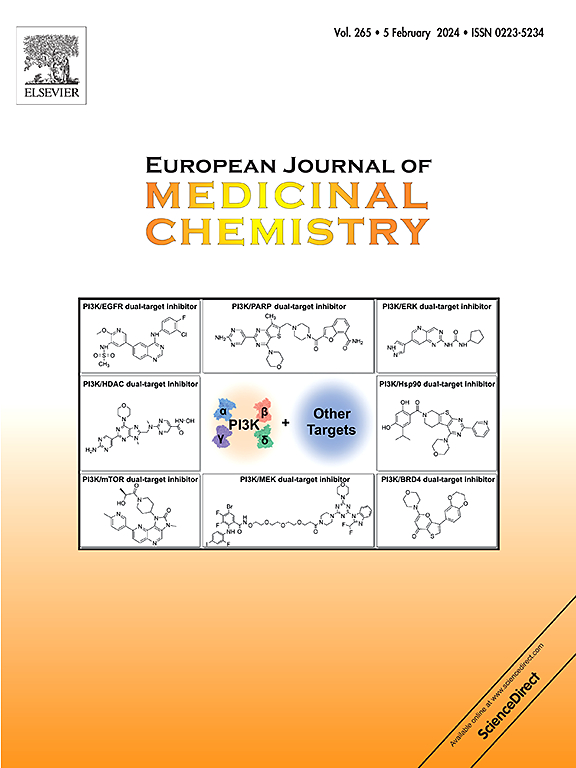烷基芳基苯乙烯吲哚染料作为靶向线粒体的荧光成像和治疗探针
IF 6
2区 医学
Q1 CHEMISTRY, MEDICINAL
引用次数: 0
摘要
对肿瘤细胞具有治疗潜力的线粒体靶向荧光化合物的开发仍然是一个非常有趣的话题。受先前报道的基于苯乙烯染料框架的离域亲脂性阳离子(dlc)的启发,我们介绍了一系列17种新型苯乙烯染料,其中几种染料与其母体化合物相比具有增强的光学性能。大多数染料表现出强烈的斯托克斯位移(104-112 nm),这主要是由于吲哚基发色团的作用,其他取代基的影响很小。这些染料与ds-DNA/RNA的凹槽非共价结合,具有中等亲和力,荧光显著增加。所选择的衍生物有效地穿透活的人类细胞,主要在线粒体中积累并变得高度荧光。然而,它们的生物活性受到细微结构修饰的强烈影响。值得注意的是,在吲哚环上引入溴取代基将非细胞毒性染料转化为高细胞毒性类似物10a和10g。有趣的是,虽然用10a和10g处理的A549肿瘤细胞表现出相似的细胞毒性反应,但正常细胞和癌细胞之间的潜在机制不同。在WI-38细胞中,毒性似乎是由线粒体过度激活和氧化应激引起的,而在A549细胞中,毒性是由线粒体功能障碍和代谢崩溃驱动的。这一区别强调了正常细胞和癌细胞之间线粒体代谢的关键差异,将10a和10g定位为有前途的先导化合物,可以进一步开发为针对癌症线粒体脆弱性的治疗药物。本文章由计算机程序翻译,如有差异,请以英文原文为准。


Alkyl-aryl styryl-indole dyes as fluorescent imaging and theranostic probes targeting mitochondria
The development of mitochondria-targeting fluorescent compounds with theranostic potential for tumor cells remains a topic of great interest. Inspired by previously reported delocalized lipophilic cations (DLCs) based on styryl dye framework, we introduce a series of seventeen novel styrene dyes, several of which exhibit enhanced optical properties compared to their parent compounds. Most dyes display strong Stokes shifts (104–112 nm), primarily due to the indolyl chromophore, with minimal influence from other substituents. These dyes bind noncovalently to the grooves of ds-DNA/RNA with moderate affinity, responding by significantly increased fluorescence. The selected derivatives effectively penetrate living human cells, accumulating primarily in mitochondria and becoming highly fluorescent. However, their bioactivity is strongly influenced by subtle structural modifications. Notably, the introduction of a bromo-substituent to the indole ring converts a non-cytotoxic dye into the highly cytotoxic analogues 10a and 10g. Interestingly, while A549 tumor cells treated with 10a and 10g exhibit similar cytotoxic responses, the underlying mechanisms differ between normal and cancerous cells. In WI-38 cells, toxicity appeared to result from mitochondrial hyperactivation and oxidative stress, whereas in A549 cells, it is driven by mitochondrial dysfunction and metabolic collapse. This distinction underscores key differences in mitochondrial metabolism between normal and cancer cells, positioning 10a and 10g as promising lead compounds for further development as theranostic agents targeting mitochondrial vulnerabilities in cancer.
求助全文
通过发布文献求助,成功后即可免费获取论文全文。
去求助
来源期刊
CiteScore
11.70
自引率
9.00%
发文量
863
审稿时长
29 days
期刊介绍:
The European Journal of Medicinal Chemistry is a global journal that publishes studies on all aspects of medicinal chemistry. It provides a medium for publication of original papers and also welcomes critical review papers.
A typical paper would report on the organic synthesis, characterization and pharmacological evaluation of compounds. Other topics of interest are drug design, QSAR, molecular modeling, drug-receptor interactions, molecular aspects of drug metabolism, prodrug synthesis and drug targeting. The journal expects manuscripts to present the rational for a study, provide insight into the design of compounds or understanding of mechanism, or clarify the targets.

 求助内容:
求助内容: 应助结果提醒方式:
应助结果提醒方式:


